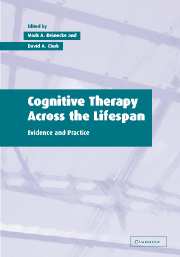Book contents
- Frontmatter
- Contents
- List of contributors
- Foreword
- 1 Cognitive therapy across the lifespan: conceptual horizons
- 2 Cognitive theory and therapy of depression
- 3 Cognitive theory and therapy of bipolar disorders
- 4 Regulation of emotion in generalized anxiety disorder
- 5 Cognitive theory and therapy of obsessions and compulsions
- 6 The cognitive model of panic
- 7 Treating obsessional problems using cognitive-behavioral therapy
- 8 Narcissistic personality disorder
- 9 Cognitive therapy and the self
- 10 Promoting cognitive change in posttraumatic stress disorder
- 11 Cognitive theory and therapy of social phobia
- 12 The cognitive model of bulimia nervosa
- 13 Cognitive therapy and schizophrenia
- 14 Cognitive-behavioral interventions for alcohol abuse and dependence
- 15 Cognitive approaches to understanding, preventing and treating child and adolescent depression
- 16 Cognitive-behavioral interventions in childhood anxiety disorders
- 17 Attention deficit/hyperactivity disorder
- 18 Cognitive-behavioral interventions for children with conduct problems
- 19 Processes of change in cognitive therapy
- 20 Cognitive therapy in the twenty-first century: current status and future directions
- Index
7 - Treating obsessional problems using cognitive-behavioral therapy
Published online by Cambridge University Press: 05 July 2014
- Frontmatter
- Contents
- List of contributors
- Foreword
- 1 Cognitive therapy across the lifespan: conceptual horizons
- 2 Cognitive theory and therapy of depression
- 3 Cognitive theory and therapy of bipolar disorders
- 4 Regulation of emotion in generalized anxiety disorder
- 5 Cognitive theory and therapy of obsessions and compulsions
- 6 The cognitive model of panic
- 7 Treating obsessional problems using cognitive-behavioral therapy
- 8 Narcissistic personality disorder
- 9 Cognitive therapy and the self
- 10 Promoting cognitive change in posttraumatic stress disorder
- 11 Cognitive theory and therapy of social phobia
- 12 The cognitive model of bulimia nervosa
- 13 Cognitive therapy and schizophrenia
- 14 Cognitive-behavioral interventions for alcohol abuse and dependence
- 15 Cognitive approaches to understanding, preventing and treating child and adolescent depression
- 16 Cognitive-behavioral interventions in childhood anxiety disorders
- 17 Attention deficit/hyperactivity disorder
- 18 Cognitive-behavioral interventions for children with conduct problems
- 19 Processes of change in cognitive therapy
- 20 Cognitive therapy in the twenty-first century: current status and future directions
- Index
Summary
The earliest description of behavioral treatment of obsessive-compulsive disorder (OCD) was by Vic Meyer (1966), in a paper titled Modification of expectations in cases with obsessional rituals. This work formed the nucleus of what came to be known as exposure and response prevention (ERP) (Rachman and Hodgson, 1980). This cognitive emphasis in the earliest description of behavioral treatment reflects a recurring theme throughout the theoretical, experimental, and clinical development of this line of psychological treatment. However, the importance of cognitive factors was reflected in a more diffuse understanding of their likely significance rather than a specific recognition of their nature. For example, Marks in 1981 pointed out that:
Obsessives develop a more elaborate set of beliefs around their rituals than phobics develop around their fears. Cognitions seem to play a larger role in obsessives than in phobics. Minor changes in obsessives’ perception of a situation can therefore produce a marked change in their behaviour
(Marks, 1981, p. 40).In 1976, Rachman and colleagues had more systematically identified a similar phenomenon as an intriguing observation during experiments on the “spontaneous decay” of compulsive urges. In this ground-breaking series of experiments, the researchers both predicted and demonstrated that behavioral rituals were associated with an immediate reduction in discomfort and urge to ritualize further rather than an increase (as predicted by other theories current at that time). A subsequent reduction of discomfort and the urge to wash in people who did not engage in their ritual over the longer term was also noted.
- Type
- Chapter
- Information
- Cognitive Therapy across the LifespanEvidence and Practice, pp. 138 - 171Publisher: Cambridge University PressPrint publication year: 2003
- 4
- Cited by



